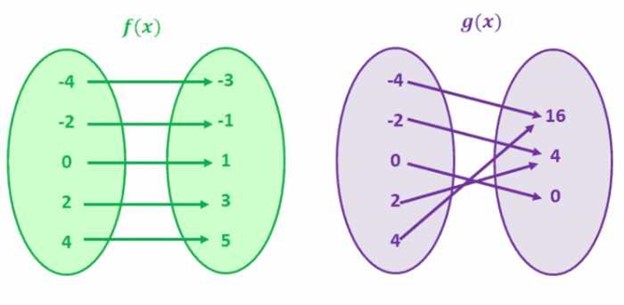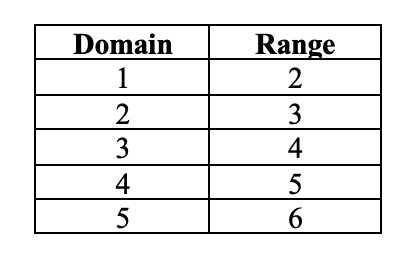One to One Functions - Graph, Examples | Horizontal Line Test
What is a One to One Function?
A one-to-one function is a mathematical function where each input correlates to just one output. So, for every x, there is just one y and vice versa. This implies that the graph of a one-to-one function will never intersect.
The input value in a one-to-one function is the domain of the function, and the output value is noted as the range of the function.
Let's look at the examples below:

For f(x), each value in the left circle corresponds to a unique value in the right circle. Similarly, every value on the right correlates to a unique value on the left. In mathematical terms, this means that every domain holds a unique range, and every range holds a unique domain. Thus, this is an example of a one-to-one function.
Here are some more examples of one-to-one functions:
-
f(x) = x + 1
-
f(x) = 2x
Now let's study the second example, which displays the values for g(x).
Notice that the inputs in the left circle (domain) do not have unique outputs in the right circle (range). Case in point, the inputs -2 and 2 have the same output, i.e., 4. In conjunction, the inputs -4 and 4 have the same output, i.e., 16. We can discern that there are identical Y values for numerous X values. Therefore, this is not a one-to-one function.
Here are additional examples of non one-to-one functions:
-
f(x) = x^2
-
f(x)=(x+2)^2
What are the qualities of One to One Functions?
One-to-one functions have these qualities:
-
The function owns an inverse.
-
The graph of the function is a line that does not intersect itself.
-
It passes the horizontal line test.
-
The graph of a function and its inverse are the same regarding the line y = x.
How to Graph a One to One Function
To graph a one-to-one function, you are required to figure out the domain and range for the function. Let's examine a simple representation of a function f(x) = x + 1.

As soon as you know the domain and the range for the function, you have to chart the domain values on the X-axis and range values on the Y-axis.
How can you evaluate if a Function is One to One?
To test whether a function is one-to-one, we can apply the horizontal line test. Immediately after you chart the graph of a function, draw horizontal lines over the graph. If a horizontal line intersects the graph of the function at more than one place, then the function is not one-to-one.
Because the graph of every linear function is a straight line, and a horizontal line doesn’t intersect the graph at more than one point, we can also reason that all linear functions are one-to-one functions. Remember that we do not use the vertical line test for one-to-one functions.
Let's examine the graph for f(x) = x + 1. As soon as you plot the values of x-coordinates and y-coordinates, you ought to review whether a horizontal line intersects the graph at more than one spot. In this example, the graph does not intersect any horizontal line more than once. This signifies that the function is a one-to-one function.

Subsequently, if the function is not a one-to-one function, it will intersect the same horizontal line multiple times. Let's study the figure for the f(y) = y^2. Here are the domain and the range values for the function:

Here is the graph for the function:

In this example, the graph crosses multiple horizontal lines. For example, for each domains -1 and 1, the range is 1. Similarly, for each -2 and 2, the range is 4. This signifies that f(x) = x^2 is not a one-to-one function.
What is the inverse of a One-to-One Function?
Since a one-to-one function has only one input value for each output value, the inverse of a one-to-one function is also a one-to-one function. The inverse of the function essentially reverses the function.
Case in point, in the event of f(x) = x + 1, we add 1 to each value of x in order to get the output, or y. The opposite of this function will subtract 1 from each value of y.
The inverse of the function is f−1.
What are the characteristics of the inverse of a One to One Function?
The characteristics of an inverse one-to-one function are identical to any other one-to-one functions. This signifies that the opposite of a one-to-one function will possess one domain for each range and pass the horizontal line test.
How do you figure out the inverse of a One-to-One Function?
Figuring out the inverse of a function is simple. You just need to change the x and y values. For instance, the inverse of the function f(x) = x + 5 is f-1(x) = x - 5.

As we discussed before, the inverse of a one-to-one function reverses the function. Since the original output value showed us we needed to add 5 to each input value, the new output value will require us to subtract 5 from each input value.
One to One Function Practice Examples
Contemplate these functions:
-
f(x) = x + 1
-
f(x) = 2x
-
f(x) = x2
-
f(x) = 3x - 2
-
f(x) = |x|
-
g(x) = 2x + 1
-
h(x) = x/2 - 1
-
j(x) = √x
-
k(x) = (x + 2)/(x - 2)
-
l(x) = 3√x
-
m(x) = 5 - x
For any of these functions:
1. Determine whether or not the function is one-to-one.
2. Chart the function and its inverse.
3. Find the inverse of the function algebraically.
4. Specify the domain and range of both the function and its inverse.
5. Use the inverse to solve for x in each calculation.
Grade Potential Can Help You Master You Functions
If you are facing difficulties trying to learn one-to-one functions or similar concepts, Grade Potential can put you in contact with a one on one instructor who can support you. Our Durham math tutors are experienced educators who help students just like you advance their understanding of these concepts.
With Grade Potential, you can study at your individual pace from the convenience of your own home. Plan an appointment with Grade Potential today by calling (919) 628-4998 to learn more about our educational services. One of our team members will contact you to better determine your requirements to provide you with the best teacher for you!




